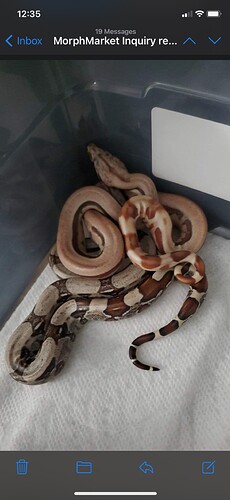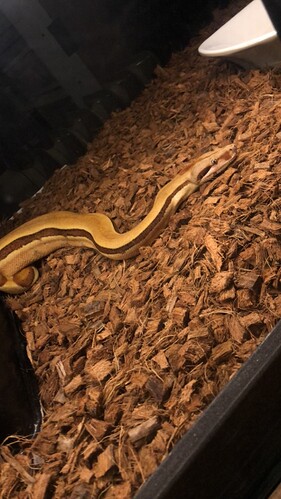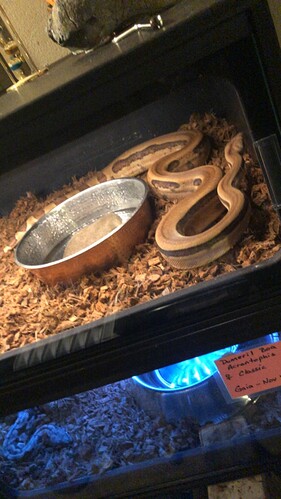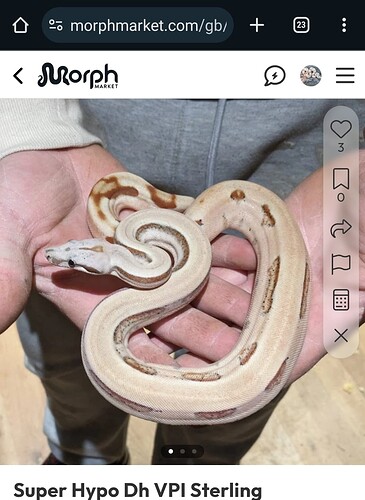Can anyone tell me what’s going on with my Boa, morph wise? So this Boa hypo, 66% HET sterling. Not even actually sterling, only het, but her pattern has like a broken sterling thing going on. (A little back story, this snake was born from a Female Boa who did not breed, but one day popped out ONLY 2 babies, and this snake was one of them. She’s a good 3 year going on 4 year old boa, and very healthy. I’m just here wondering if anyone could verify what’s happening here because I’m not really sure
I’m probably not going to be super helpful, but if your female didn’t breed, and just popped out these babies, then it could have been a parthogenesis clutch, in which case, she could be sterling.
That being said, I love it, and I want it ![]()
This is rare but possible. When I was first breeding Boas I remember reading about it and had to do a little research again to find it. But here is a article Evidence for viable, non-clonal but fatherless Boa constrictors - PMC
These two littermates will be non-clones of their mother.
If you did not have the mother from breeding age, she can hold a males sperm for 21 months after mating.
I’ll tag @tommccarthy & @t_h_wyman because I feel they’d be helpful here.
The article title specifically notes the animals were non-clonal. There’s a BP Parthenogenesis thread that has some great info as to how the genetic bit works out.
I should have proof read my response prior. Thank you for pointing that out. A lot going on the past week or so.
No worries, we’ve all definitely made similar proof reading errors. Sometimes I have to edit my posts 4-5 times just to make sense on a distracted day. ![]() Hopefully your weekend allows you some decompression time!
Hopefully your weekend allows you some decompression time!
I wish that was going to be the case. Sadly it will be a long weekend for me.
I don’t think I have ever seen a sterling with such defined patterning but I have also never seen a super hypo sterling so it very well could be. The first thing I thought of when I saw it was Scoria but I don’t think it is. I have zero clue other than she is really good looking and has hypo
@mattcookreptiles @lumpy you both have sterlings ![]()
This is actually a pretty common occurance with sterling stuff, reverse stripes.
Theres a few similar ones on MM right now
She is a real beauty for sure!
Also, as mentioned above there are parthogenesis babies that do not double up on the moms genes and will give you babies like in this case that are not visual sterlings.
Be warned however that most if not all Partho babies are infertile.
Im actually curious about it was decided that its a 66% het sterling if the mom never saw a male. 66% hets are only from 100% het x 100% het pairings.
She is simply outstanding! In fact if the one picture is of both babies the other baby is outstanding as well! And momma is a looker as well!
I would say congratulations are in order! Hopefully there are no infertility problems?……
I always find genetics fascinating. Partho stuff is simply wild.
Now I’m confused. 66% het just means 66% possibility of being het, which as you say is what the odds are if an animal’s parents are both het for a trait. This is determined by parentage. It is not connected to being bred. After being bred to test a het (or in the lucky breeds with genetic tests, being tested for a trait), one can know if an animal is or isn’t actually het.
Separate note (not directed at @mattcookreptiles who is a very knowledgeable and experienced person), I gotta say that I really dislike the terminology the hobby has shifted to around possible hets. So many newer people are confused by “50% het” or “66% het” and think an animal is literally partially het for a trait. Not possible. I wish we’d go back to tagging percentage “pos het,” “possible het” or something clearer. Heck, “66% PH” is even one character shorter than “66% het” AND is less confusing. …slithers sheepishly off old teacher’s soapbox.…
I was very confused by this when I first started getting exposed to reptile genetics lingo. I thought it was saying that a reptile had a fraction of a gene, and it made me question everything I thought I knew about genetics…which, admittedly, was not much, but I was still pretty sure that an animal couldn’t have 66% of a gene, and I was seriously confused that people seemed to be saying that their animals were exactly that. ![]()
![]()
Maybe im just tired today because im making it more confusing for people, this whole post is confusing lol im asking why its being labled as a 66% possible het when its claimed to be a partho baby.
100% hets are created when a visual animal breeds
66% poss hets are created when two 100% het boas are bred together.
50% poss hets are created when a 100% het breeds to something not carrying the trait
Parthogenesis is when a boa has babies without ever seeing a male. They are also typically infertile so there isnt much chance or proving any hidden genetics. A boa born from a partho litter cannot be a 66% poss het.
My question is that this boa is being labled as a 66% possible het while be labled as a partho born baby. That means its not resulting from a 100% x 100% het pairing, so what is the reasoning behind calling it a 66% poss het? Its a genuine question because I dont know what id label a partho babys het as.
I wonder if OP meant that MOM was 66% possible het. I dunno. Gorgeous baby regardless ![]()
I could see that!
I’m thinking this, too. It’s a common misconception that partho babies are clones of mom, so perhaps she was the 66% ph.





